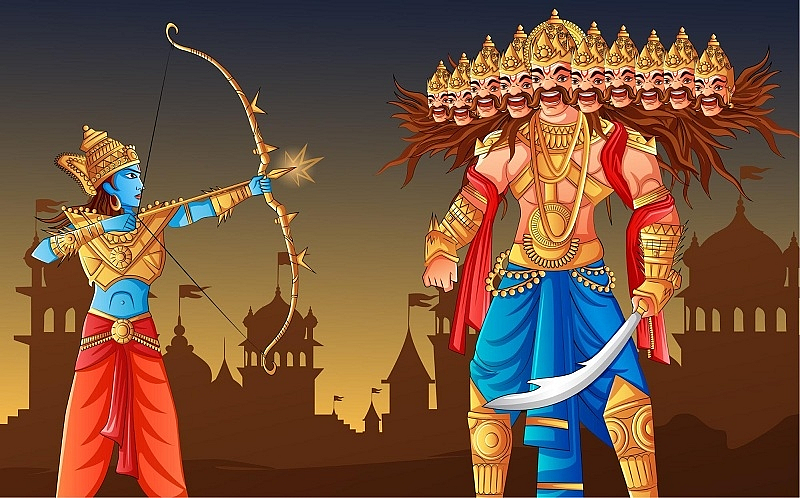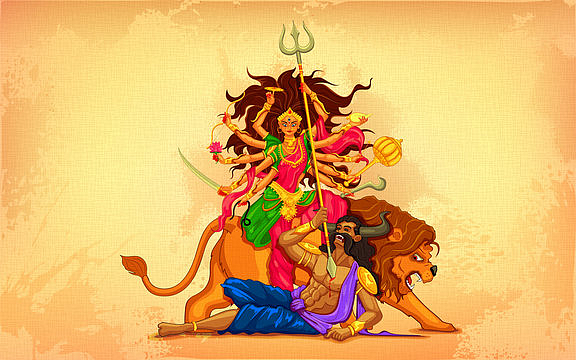Chaitra Navratri is a significant Hindu festival that marks the beginning of the new year as per the Hindu lunar calendar. It is celebrated in Chaitra (March-April) and is dedicated to the nine forms of Goddess Durga, symbolising the victory of good over evil. Chaitra Navratri holds great mythological significance, with several stories associated with its origins and spiritual importance.
The Legends of Mahishasura and Goddess Durga

One of the most widely known myths associated with Chaitra Navratri is the battle between Goddess Durga and the demon Mahishasura. Mahishasura, a powerful demon, received a boon from Lord Brahma that he could not be killed by any man or god. Empowered by this boon, he wreaked havoc on earth and even conquered the heavens, defeating the gods. In response to his tyranny, the Trinity of Brahma, Vishnu, and Shiva combined their energies to create Goddess Durga, an embodiment of divine strength and power. The battle between Goddess Durga and Mahishasura lasted for nine days, culminating in his death on the tenth day. This victory is celebrated as Vijaya Dashami, and the preceding nine days of struggle symbolize the nine days of Navratri.
The Story of Rama and Ravana

Chaitra Navratri also holds significant importance in the context of the epic Ramayana. According to legend, Lord Rama started his journey to Lanka during Chaitra Navratri to rescue his wife, Sita, from the clutches of the demon king Ravana. It is believed that Rama observed nine days of fasting and prayed to Goddess Durga for strength and blessings before embarking on his mission. He invoked the Goddess for her divine assistance in his fight against Ravana and his powerful army. This devotion to Durga during Chaitra Navratri is considered to have empowered Rama and ultimately led to his victory over Ravana.
The Story of Shakti Peethas and Goddess Sati

Another important legend linked to Chaitra Navratri is the story of Goddess Sati and the creation of Shakti Peethas. According to Hindu mythology, Goddess Sati, the consort of Lord Shiva, immolated herself in the sacrificial fire after her father, King Daksha, insulted Lord Shiva. Overcome with grief, Lord Shiva carried her burning body across the universe, leading to the establishment of 51 Shakti Peethas, where her body parts fell. Chaitra Navratri is believed to be an auspicious time to worship the Goddess in her various forms, and many devotees visit these Shakti Peethas to seek divine blessings.
The Tale of King Suratha and the Markandeya Purana

The significance of Navratri is also highlighted in the Markandeya Purana, where King Suratha, a noble ruler, loses his kingdom due to deceit. Along with a merchant named Samadhi, he seeks spiritual guidance from Sage Medha. The sage narrates the divine story of Goddess Durga, explaining how she protects her devotees and restores justice. Inspired by the tale, King Suratha and Samadhi undertake rigorous penance and worship Goddess Durga, who blesses them with wisdom and grants Suratha his lost kingdom. This story emphasizes the power of devotion and perseverance, reinforcing the importance of Chaitra Navratri.
The Awakening of the Goddess: Connecting with the Shakti Within
Beyond the specific narratives, the underlying theme of Chaitra Navratri revolves around the awakening of the Shakti, the divine feminine energy, within each individual. The stories of Durga's battles against demons and her various forms represent the constant struggle between good and evil that exists within ourselves. The fasting, prayers, and rituals performed during Navratri are aimed at purifying the body and mind, allowing the inner Shakti to manifest and empowering individuals to overcome their weaknesses, achieve their goals, and connect with their true potential.
The Significance of Ghatasthapana and Kalash Sthapana

The Ghatasthapana ritual, which marks the beginning of Chaitra Navratri, has its own mythological relevance. It is believed that during this time, Goddess Durga descends upon the earth to bless her devotees. The Kalash (sacred pot) symbolizes the presence of the Goddess, and performing the ritual invokes divine energy, prosperity, and protection.
The mythological stories associated with Chaitra Navratri are more than just ancient tales; they are profound narratives that offer valuable lessons about righteousness, courage, devotion, and the power of the Divine Feminine. By understanding the significance of these stories, devotees can connect with the deeper meaning of the festival and utilize its energy to overcome challenges, cultivate inner strength, and embark on a path of spiritual growth. As we celebrate Chaitra Navratri, let us remember the stories of Durga, Rama, and the Nav Durga, and strive to embody the virtues of righteousness, courage, and compassion in our daily lives. May the blessings of the Goddess be upon us all.
Follow 바카라 Experiences:
| | |















